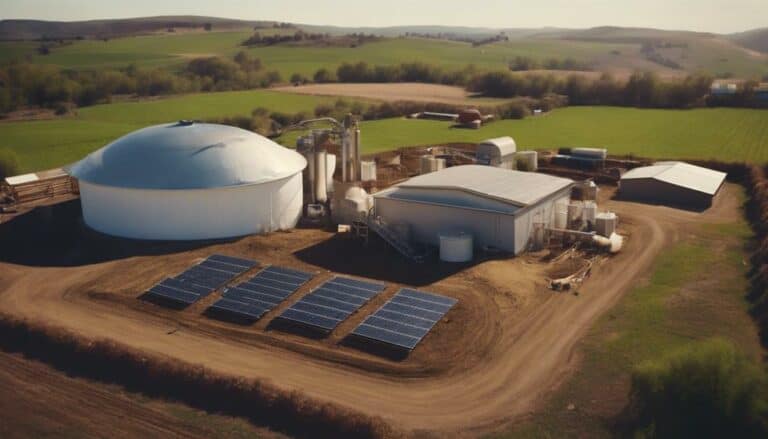Transform scraps on your ranch into valuable energy through anaerobic digestion. Microorganisms break down waste, creating renewable energy like methane. Strategic waste collection covering 10-15 miles daily and proper separation are essential. Anaerobic digestion also converts food waste into biogas for heat, electricity, or biomethane upgrade. Leveraging organic materials promotes sustainable farming, reducing GHG emissions and traditional energy reliance. This process not only decreases landfill waste but also enhances environmental sustainability by recycling food waste into energy. Start converting waste into energy on your ranch today with anaerobic digestion for a greener future.
Key Takeaways
- Anaerobic digestion converts organic waste into biogas for energy.
- Efficient biogas production reduces methane emissions and landfill waste.
- Integration of renewable energy systems promotes sustainable ranching practices.
- Upgrading biogas enhances energy production and reduces reliance on traditional sources.
- Waste-to-energy systems recycle food waste, reducing carbon footprint and enhancing environmental sustainability.
Anaerobic Digestion Process Overview
Utilizing anaerobic digestion on the ranch involves the efficient conversion of organic waste into valuable energy through the action of microorganisms in the absence of oxygen. This process is a sustainable solution for waste management, as it not only helps in reducing greenhouse gas emissions but also generates renewable energy in the form of methane. Microorganisms play an essential role in breaking down the organic waste, producing methane that can be utilized for electricity generation. By capturing methane, anaerobic digestion aids in mitigating greenhouse gas emissions that would otherwise contribute to climate change.
The beauty of anaerobic digestion lies in its dual benefits of waste management and energy production. By harnessing the power of microorganisms, the ranch can turn what was once considered waste into a valuable resource. This innovative approach not only addresses environmental concerns but also provides a practical solution for sustainable energy generation on the ranch. Embracing anaerobic digestion showcases a commitment to environmental stewardship and efficient resource utilization.
Organic Waste Collection Methods
To optimize the efficiency of organic waste collection on the ranch, strategic planning and effective coordination are essential components. Collection teams covering 10-15 miles per day play an important role in gathering food waste.
Trucks, capable of collecting around 20 tons of organic waste daily, are instrumental in this process. Proper waste separation is key to ensuring effective organic waste recycling.
Peak times like Halloween and Christmas see an increase in organic waste generation, requiring heightened collection efforts. Educating residents on the significance of proper waste disposal practices is paramount for successful organic waste recycling.
Biogas Production and Capture Techniques
When considering biogas production and capture techniques, one must understand the process of anaerobic digestion and its role in generating renewable energy. Anaerobic digestion breaks down organic materials like food waste into biogas, primarily methane and carbon dioxide. This process not only helps in converting food waste into renewable energy but also plays a crucial role in waste management by reducing greenhouse gas emissions, particularly methane. To enhance biogas yields, co-digestion, which involves combining different organic materials, can be employed. Biogas produced can then be utilized for heat, electricity production, or upgraded into biomethane for various applications. Implementing biogas systems on ranches not only contributes to sustainable energy practices but also aids in mitigating methane emissions, lowering waste management costs, and providing economic benefits to the ranching community.
| Biogas Production and Capture Techniques | |
|---|---|
| Process | Anaerobic Digestion |
| Output | Methane, CO2, Trace Gases |
| Benefits | Renewable Energy, Waste Management, Greenhouse Gas Reduction |
Renewable Energy Applications on Ranches
Renewable energy applications on ranches leverage organic materials like manure, food waste, and farm by-products to power not only the operations themselves but also potentially hundreds of homes in surrounding communities. Through the use of anaerobic digesters, these materials are efficiently converted into biogas, a renewable energy source that can be further processed to generate electricity.
Upgrades, often supported by grants, play a vital role in enhancing energy production on ranches, making these operations more self-sustainable and environmentally friendly. By integrating renewable energy applications, ranches actively contribute to sustainable farming practices and promote environmental protection.
The utilization of food waste and organic waste for energy production not only benefits the ranches themselves but also has a positive ripple effect on the broader community, reducing reliance on traditional energy sources and lowering greenhouse gas emissions. Embracing renewable energy on ranches showcases an innovative approach to energy production, demonstrating the potential for a more sustainable future in agriculture.
Environmental Benefits of Waste-to-Energy Systems
Leveraging waste-to-energy systems not only reduces landfill waste and methane emissions but also greatly contributes to enhancing environmental sustainability. By converting organic waste into power, these systems play an important role in reducing greenhouse gas emissions. Through anaerobic digestion, waste materials are processed, preventing CO2 emissions and generating renewable electricity. Recycling food waste into energy not only helps in closing the loop on sustainability but also notably reduces the carbon footprint. As legislation may soon mandate separate food waste collections, waste-to-energy initiatives are expected to increase, further promoting the efficient use of resources. The table below outlines the key environmental benefits of waste-to-energy systems:
| Keywords | Benefits |
|---|---|
| Food | Recycling food waste into energy helps reduce the carbon footprint. |
| Waste | Waste-to-energy systems reduce landfill waste and methane emissions. |
| Power | Converting organic waste into power contributes to energy production. |
| Organic | Anaerobic digestion of organic waste prevents CO2 emissions. |
| Gas | Methane captured from waste materials can be used for energy production. |
Conclusion
By harnessing the power of anaerobic digestion, ranches can turn their organic waste into a valuable source of renewable energy. This innovative waste-to-energy solution not only helps reduce greenhouse gas emissions, but also provides a sustainable way to generate electricity and heat for on-site use.
Embracing this technology can lead to a more environmentally friendly and economically viable future for ranching operations.

